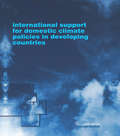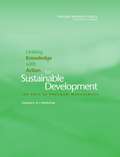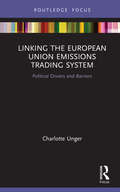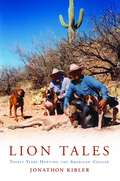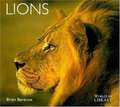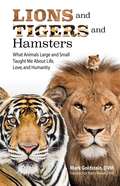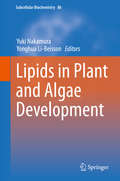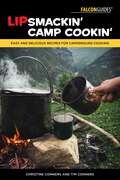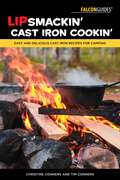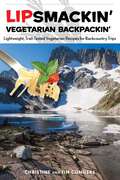- Table View
- List View
Linking Emissions Trading Schemes (Climate Policy Ser.)
by Andreas TuerkA growing number of GHG emissions trading schemes are being implemented at regional or national levels. However, even as the number of different schemes grows, few linkages exist between them. Major cap-and-trade proposals are currently at important stages in their development, especially in the United States, Japan and Australia, some of which explicitly emphasize the aim of linking with other schemes. One of the strategic goals of European climate policy is linking the EU ETS with other comparable schemes. The research presented in this volume is on actual economic, political and institutional constraints and implications. It examines the role of linking trading schemes for the development of the post-Kyoto climate architecture and for increasing linkage between schemes. This essential research will be relevant to both the scientific community and for policymakers who are involved in the design of emerging trading schemes and offset mechanisms, as well as in designing the post Kyoto climate regime. This volume focuses specifically on: o Economic, institutional/regulatory and legal dimensions of linking o Implications of linking on the design of emerging trading schemes o The role of linking trading schemes for the development of the post-Kyoto climate regime
Linking Knowledge with Action for Sustainable Development: THE ROLE OF PROGRAM MANAGEMENT
by National Research Council of the National AcademiesThis report summarizes a workshop organized by the National Academies’ Roundtable on Science and Technology for Sustainability. The workshop brought together a select group of program managers from the public and private sectors to discuss specific cases of linking knowledge to action in a diverse set of integrated observation, assessment, and decision support systems. Workshop discussions explored a wide variety of experiments in harnessing science and technology to goals of promoting development and conserving the environment. Participants reflected on the most significant challenges that they have faced when trying to implement their programs and the strategies that they have used to address them successfully. The report summarizes discussions at the workshop, including common themes about the process of linking knowledge with actions for sustainable development that emerged across a wide range of cases, sectors, and regions.
Linking Urban and Rural Tourism
by Carol Kline Susan L. SlocumDestinations rely on regional strategies to support and enhance the tourism product through regional partnerships and integration. Integrated tourism is defined as tourism that is explicitly linked to the economic, social, cultural, natural and human structures of the region in which it occurs. Integrated tourism has evolved to include numerous meanings and definitions, but generally includes a vertical business or industry approach. The first of its kind, this book applies a more inclusive approach to integration by providing insight into inclusive regional development strategies that support both the needs of urban and rural areas whilst enhancing the tourist experience, supporting the positive impacts of tourism and mitigating the negative. Regional studies tend to portray either an urban or rural focus without acknowledging that often these spaces constitute joint governance structures, similar historical and cultural roots, and economic dependencies. Sustainable tourism promotes sourcing locally, such as using rural agricultural products in urban tourism experiences. Furthermore, innovative rural marketing strategies linking tourism heritage, attractions, food and drink trails, and artisans with urban visitors are emerging. Including theoretical and applied research and international case studies, this will be a valuable resource to academics, students and practitioners working in tourism development and regional policy.
Linking the European Union Emissions Trading System: Political Drivers and Barriers (Routledge Focus on Environment and Sustainability)
by Charlotte UngerThis book focuses on the linking of the European Union Emissions Trading System (EU ETS) with other independent regional ETS. While rich practical and academic research has evolved on the economic and technical side of ETS linking, political drivers and barriers have so far been underrepresented in this debate. Filling this lacuna and based on international relations theory, existing research and qualitative fieldwork, this book introduces the range of political conditions that influence linking, such as political leadership and stakeholder activity. Specifically, it analyzes which of these aspects have played a role in three different linking activities of the EU: (1) a failed linking attempt: EU ETS–California Cap-and-Trade Program; (2) a successful linking treaty: EU ETS–Switzerland Emissions Trading System; and (3) an agreed-upon but not realized link: EU ETS–Australia Carbon Pricing Mechanism. Through an interrogation of these examples, Dr. Unger concludes that it is not only the technical challenges or the overall economic benefit but rather domestic interests, structural aspects, and external international political developments that have jointly dominated linking activities, especially those in which the EU takes part. This book will be of great interest to scholars and policy-makers working in climate policy and EU environmental politics.
Lion Hearted: The Life and Death of Cecil & the Future of Africa's Iconic Cats
by Andrew Loveridge“Until the lion has its own storyteller, tales of the lion hunt will always glorify the hunter.” —Zimbabwean proverbIn 2015, an American hunter named Walter Palmer shot and killed a lion named Cecil. The lion was one of dozens slain each year in Zimbabwe, which legally licenses the hunting of big cats. But Cecil’s death sparked unprecedented global outrage, igniting thousands of media reports about the peculiar circumstances surrounding this hunt. At the center of the controversy was Dr. Andrew Loveridge, the zoologist who had studied Cecil for eight years. In Lion Hearted, Loveridge pieces together, for the first time, the fascinating life and murky details of this beloved lion’s slaying. In the tradition of Born Free and Gorillas in the Mist, Lion Hearted chronicles Loveridge’s long acquaintance with a host of charismatic lions that his team has tracked, often from birth to death. Born and raised in Zimbabwe, Loveridge learned to love predators at the knee of his father, an eminent herpetologist who stored baby crocodiles in the family bathtub. After earning his doctorate at Oxford, he seized an invitation to study the lions of Zimbabwe’s Hwange National Park. There he meets Stumpy Tail, who, despite her name, has the dignity of the Queen of the Animal Kingdom; Dynamite, a venerable coalition leader who, muscled out by younger males, sets off on an incredible thirty-seven-day, 137-mile journey to find a new home; and Kataza, who escapes another lion’s claws, and whom Loveridge twice saves from death at the hands of humans. And, of course, there is Cecil. Dethroned in an epic battle, he forms an alliance with a former rival. He also becomes a favorite of photographers and tourists—until the fateful night when a Minnesota dentist and his hunting guide entice the trusting cat with a free meal. Loveridge unravels the complexities of lion society and the dangers the cats face both within their ranks and from the outside world. Despite their ruthless reputation, lions can form deep emotional bonds—females live in prides, a sisterhood of mothers, daughters, sisters, and aunts that can exhibit military precision when hunting in formation; males band together in coalitions to vie for control of territory and the female prides. They also display a wide range of emotional behavior, including mourning the loss of their mates, partners, and cubs. Africa’s lion population is estimated to have shrunk by 43 percent in the last twenty years. There may now be as few as 20,000 wild lions across the entire continent—far fewer than the number of elephants. While deploring the killing of lions for sport, Loveridge does not believe that banning trophy hunting, by itself, will halt the decline of Africa’s lion populations. He sees greater threats in human population growth, the loss of habitat to agriculture, and the illegal trade in lion body parts for use in traditional medicines. And he offers concrete proposals for averting the lion’s extinction. More than a gripping detective story, Lion Hearted is an exploration of humanity’s relationship with the natural world and an attempt to keep this majestic species from disappearing. “Lions are one of the most beloved animals on the planet,” Loveridge observes. “They are the national symbol of no fewer than fifteen countries. . . . Surely, we can think of a better way to save the wild animals we love besides killing them.”
Lion Hound (Famous Dog Stories)
by Jim KjelgaardLion Hound is a tense and gripping tale of hunting and wilderness life. The wild rimrock gpuntry of Arizona is the scene which concerns young Johnny Torrington, his grandfather, a red hound pup, and their efforts to track down a marauding mountain lion.
Lion Tales: Thirty Years Hunting the American Cougar
by Walt Prothero Jonathon KiblerJonathon Kibler, a cougar-hunting specialist, has been hunting American lions since his early teens. Hunting lions with hounds on dry ground in the Southwest is arguably the hardest method of hunting these large cats. Kibler has mastered this skill and his hunting adventures have elevated him with the Lee brothers and Ben Lilly to a legendary status as a master lion hunter of the American Southwest. He&’s one of the last of a handful of purists who disdains any method other than dry-ground, fair-chase hunting. In his more than three decades of chasing lions through the toughest desert country in North America, he&’s guided clients to hundreds of trophy cats and captured lions for various government and private biological studies. In his quest, he&’s bred his own lion dogs and largely trains and shoes his own mules. Predictably, he&’s had close encounters in his decades astride mules in the desert wilderness, and though it has on occasion been a near thing, he&’s survived them all to write this, his first book. Kibler has followed a lion into a pitch-black cave with an ice-cold underground pool, dealt with a tom cat that eluded him for more than two years, and taken lions sitting on ledges mere inches wide and hundreds of yards up a steep cliff. Lion Tales contains some of the most interesting stories ever written on hunting mountain lions in the United States.
Lions (Nature's Children)
by Amy-Jane BeerPresents an introduction to the physical characteristics and habits of lions.
Lions (World Life Library)
by Brian BertramFrom the Book jacket: With its authoritative information based on world-recognized research, plus spectacular color photography and range maps, Lions helps readers of all ages discover fascinating facts about this phenomenal animal. This book is a wonderful introduction to the remarkably adaptable lion and its characteristics, its uniquely social nature and structure. Lions also covers research studies in the wild and the great conservation efforts being made on behalf of the Asiatic subspecies of lion. Brian Bertram is a freelance zoological advisor, acting principally for the Bristol Zoo Gardens, England, as Special Projects Coordinator. He was Curator of Mammals at the Zoological Society of London, and he spent four years studying lions and leopards in the Serengeti National Park in Tanzania. Discover the world's animals with the WorldLife Library from Voyageur Press. This highly acclaimed series brings you the latest research from leading naturalists, along with stunning color photographs of your favorite animals.
Lions and Tigers and Hamsters: What Animals Large and Small Taught Me About Life, Love, and Humanity
by Dr. Mark GoldsteinFrom the time Dr. Mark Goldstein was a little boy—even before he had his first dog—he was fascinated by creatures both domestic and wild. After graduating veterinary school at Cornell University, he became a veterinarian in clinical practice, then director of zoos in Boston and Los Angeles, then head of a progressive humane society where he advocated for animal welfare. During his extraordinary 30-year career, Dr. Mark has accrued a lifetime of experiences working with all sorts of animals and the people who care for them. Dr. Mark's life with animals taught him more than how to be a great doctor, it taught him how to live life. The stories in this book reflect those lessons; they will make you laugh and cry as they entertain and amaze you. Each real-life experience sheds light on the challenges and hard work of the talented individuals who work in the world of animal welfare. These are stories that illustrate the tremendous impact animals have on our daily lives—they are hallmarks of the sacred importance of the human-animal bond. On your journey through the exhilarating life of Dr. Mark, you'll meet some of the finned, furred, and feathered animals who offered him invaluable insights—Harold the hamster, Sasha the Siberian tiger, St. Francis the German Shepherd, Ralph the buffalo, Gus the stallion, Frank the goldfish, and many more fascinating creatures!
Lions in the Balance: Man-Eaters, Manes, and Men with Guns
by Craig PackerIf you are a morani (warrior), you have your spear at the ready—you could be the hero, but you will have to wait until the morning light before you can go out and prove yourself. If it is a lion, you want to be the first to spear it—and if the lion turns on you, make sure it mauls you on your chest or stomach, on your face, shins, or throat. Any place where you can show your scars with pride, show the incontrovertible evidence of courage. A scar on your back would be a permanent reminder of cowardice, an ineradicable trace of shame. Monsters take many forms: from man-eating lions to the people who hunt them, from armed robbers to that midnight knock at the door of a cheap hotel room in Dar es Salaam. And celebrated biologist Craig Packer has faced them all. Head on. With Lions in the Balance, Packer takes us back into the complex, tooth-and-claw world of the African lion, offering revealing insights into both the lives of one of the most iconic and dangerous animals on earth and the very real risks of protecting them. A sequel to his prize-winning Into Africa—which gave many readers their first experience of fieldwork in Africa, of cooperative lions on dusty savannas, and political kidnappings on the shores of Lake Tanganyika—this new diary-based chronicle of cutting-edge research and heartbreaking corruption will both alarm and entertain. Packer’s story offers a look into the future of the lion, one in which the politics of conservation will require survival strategies far more creative and powerful than those practiced anywhere in the world today. Packer is sure to infuriate millionaires, politicians, aid agencies, and conservationists alike as he minces no words about the problems he encounters. But with a narrative stretching from far flung parts of Africa to the corridors of power in Washington, DC, and marked by Packer’s signature humor and incredible candor, Lions in the Balance is a tale of courage against impossible odds, a masterly blend of science, adventure, and storytelling, and an urgent call to action that will captivate a new generation of readers.
Lipids in Plant and Algae Development
by Yuki Nakamura Yonghua Li-BeissonThis book summarizes recent advances in understanding the functions of plant and algal lipids in photosynthesis, in development and signaling, and in industrial applications. As readers will discover, biochemistry, enzymology and analytical chemistry, as well as gene knock-out studies have all contributed to our rapidly increasing understanding of the functions of lipids. In the past few decades, distinct physical and biochemical properties of specific lipid classes were revealed in plant and algal lipids and the functional aspects of lipids in modulating critical biological processes have been uncovered. These chapters from international authors across relevant research fields highlight the underlying evolutionary context of lipid function in photosynthetic unicellular and multicellular organisms. The book goes on to encompass what lipids can do for industrial applications at a time of fascination with plants and algae in carbon fixation and as sources for production of food, energy and novel chemicals. The developmental context is a part of the fresh and engaging perspective that is presented in this work which graduate students and scientists will find both illuminating and useful.
Lipsmackin' Backpackin': Lightweight, Trail-Tested Recipes for Backcountry Trips
by Christine Conners Tim ConnersNot a fan of bland, boring, and lifeless meals after a hard day of backpacking? Neither are the Conners, which is why you'll find their new second edition packed full of even more tasty favorites from the trails! Completely revised and updated, this all-in-one food guide builds on the format pioneered by the original, providing clear and thorough at-home and on-trail preparation directions, nutrition and serving information, and the weight of each recipe, while adding a wealth of reference information and instructional material. Pacific Crest Pancakes, Jammin' Jambalaya, and Buried Forest Trail Fudge - it's in here!
Lipsmackin' Camp Cookin': Easy and Delicious Recipes for Campground Cooking
by Christine Conners Tim ConnersDoes camping in the great outdoors put a damper on your culinary prowess? Well, stop the hand-wringing and start the fire, because Lipsmackin' Camp Cookin' will show you the way to excellent outdoor cuisine! Designed specifically with the campground setting in mind, Lipsmackin' Camp Cookin' follows the same tried-and-true approach to cooking outdoors originally pioneered in the outdoor classic, Lipsmackin' Backpackin'. Filled with plenty of camp-tested recipes, numerous techniques, clear and thorough preparation directions, extensive instruction in fundamentals, and loads of reference information, this book is sure to fill your campground with enticing aromas. Smoky Mountain Chili, Donuts on a Stick, Huli Huli Chicken, and S&’more&’s Pie - it's in here! From sun up to sun down, Lipsmackin' Camp Cookin' has you covered.
Lipsmackin' Cast Iron Cookin': Easy and Delicious Cast Iron Recipes for Camping
by Christine Conners Tim ConnersTim and Christine Conners, best-selling authors of over a dozen outdoor cookbooks, have added another title to their highly successful Lipsmackin&’ Campin&’ series! Lipsmackin&’ Cast Iron Cookin&’ is a collection of favorite recipes from outdoor chefs from around the world. The recipes are eclectic, always delicious, have easy to follow instructions, and are full of fun stories and antidotes from their contributors. Charming photographs of camp and cooking scenes are included throughout. The Conners&’ cookbooks are more than a collection of recipes: they bring their readers outdoors.
Lipsmackin' Vegetarian Backpackin': Lightweight, Trail-Tested Vegetarian Recipes for Backcountry Trips
by Christine Conners Tim ConnersTired of power bars, half-cooked quick rice, and endless trail recipes featuring dehydrated chicken by-products? Try meat-free dishes like Flyin' Brian's Triple Crown Curry Couscous, Springer Mountain Pesto, and Time-Traveler's Tamales instead. The sequel to the top-selling Lipsmackin' Backpackin', this all-in-one backpacker's food guide has more than 150 trail-tested, meatless recipes that provide at-home preparation directions, trailside cooking instructions, detailed nutritional information, serving suggestions, the weight of the ingredients, and meal-planning tips from some of the most experienced long-distance hikers in the world. The recipes are organized in six sections: breakfast, lunch, dinner, breads, snacks and desserts, and drinks. There is a separate chapter on food preparation and cooking tips, contact information for sources of ingredients, measurement conversions, and a special section of Packable Trailside Cooking Instructions--short directions for each recipe so readers don't have to pack the whole book. This is the most complete guide ever written to meatless eating on the trail, an indispensable resource for vegetarian backpackers, and a great source for recipes for anyone who wants great-tasting and nutritious meals trailside.
Liquid Asset: How Business and Government Can Partner to Solve the Freshwater Crisis
by Barton H. Thompson Jr.A sweeping, policy-oriented account of the private and public management of the world's essential natural resource. Governments dominated water management throughout the twentieth century. Tasked with ensuring a public supply of clean, safe, reliable, and affordable water, governmental agencies controlled water administration in most of the world. They built the dams, reservoirs, and aqueducts that store water when available and move that water to areas with increasing populations and economies. Private businesses sometimes played a part in managing water, but typically in a supporting position as consultants or contractors. Today, given the global need for innovative new technologies, institutions, and financing to solve the freshwater crisis, private businesses and markets are playing a rapidly expanding role, bringing both new approaches and new challenges to a historically public field. In Liquid Asset, Barton H. Thompson, Jr. examines the growing position of the private sector in the "business of water." Thompson seeks to understand the private sector's involvement in meeting the water needs of both humans and the environment, looks at the potential risks that growing private involvement poses to the public interest in water, and considers the obstacles that private organizations face in trying to participate in a traditionally governmental sector. Thompson provides a richly detailed analysis to foster both improved public policy and responsible business behavior. As the book demonstrates, the story of private businesses and water offers a window into the serious challenges facing freshwater today, and their potential solutions.
Liquid Assets
by Jill BobergMost writings linking demographic trends to water availability often look only at population-growth effects, treating water supplies as static and population as increasing, inexorably leading to a water-availability crisis. This report's more holistic view of the interaction between demographics and water resources considers more demographic and local water-availability variables. It focuses on conditions in developing countries, where these factors intersect with the fewest socioeconomic resources to mediate.
Liquid Assets: An Economic Approach for Water Management and Conflict Resolution in the Middle East and Beyond
by Franklin Fisher Annette Huber-LeeLiquid Assets shows that the common view of water as an inevitable cause of future wars is neither rational nor necessary. Typically, two or more parties with claim to the same water sources are thought to play a zero-sum game with each side placing a high emotional and political value over the ownership of the water. However, Franklin Fisher and his coauthors demonstrate that when disputes in ownership are expressed as disputes about money values, in most cases, the benefits of ownership will be surprisingly small. By assigning an economic value to water and treating water as a tradable resource, parties see that the gains from cooperation exceed the costs resulting from the change in ownership. A zero-sum game becomes a win-win situation. To support this new approach, Liquid Assets presents an innovative water allocation model that can be used to assist water management, the cost-benefit analysis of water infrastructure, and the resolution of disputes. The model takes system-wide effects into account and is the first to overcome the failure of actual water markets to cope with the divergence between social and private benefits (as implied by agricultural subsidies), permitting the model-user to impose his or her own values or policies. Liquid Assets applies its methodology to Israel, Jordan, and Palestine, a region where water is scarce and water conflicts are often thought to be explosive. Indeed, this book is the result of a joint effort of Israeli, Jordanian, Palestinian, American, and Dutch experts. But the book‘s message and methods are not restricted to the Middle East. They are applicable to water management and water disputes around the globe.
Liquid Capital: Making the Chicago Waterfront (American Business, Politics, and Society)
by Joshua A. SalzmannIn the nineteenth century, politicians transformed a disease-infested bog on the southwestern shore of Lake Michigan into an intensively managed waterscape supporting the life and economy of Chicago, now America's third-most populous city. In Liquid Capital, Joshua A. T. Salzmann shows how, through a combination of entrepreneurship, civic spirit, and bareknuckle politics, the Chicago waterfront became a hub of economic and cultural activity while also the site of many of the nation's precendent-setting decisions about public land use and environmental protection. Through the political saga of waterfront development, Salzmann illuminates Chicago's seemingly paradoxical position as both a paragon of buccaneering capitalism and assertive state power.The list of actions undertaken by local politicians and boosters to facilitate the waterfront's success is long: officials reversed a river, built a canal to fuse the Great Lakes and Mississippi River watersheds, decorated the lakeshore with parks and monuments, and enacted regulations governing the use of air, land, and water. With these feats of engineering and statecraft, they created a waterscape conducive to commodity exchange, leisure tourism, and class harmony—in sum, an invaluable resource for profit making. Their actions made the city's growth and the development of its western hinterlands possible. Liquid Capital sheds light on these precedent-making policies, their effect on Chicago's development as a major economic and cultural force, and the ways in which they continue to shape legislation regarding the use of air and water.
Liquid Empire: Water and Power in the Colonial World
by Corey RossA bold new account of European imperialism told through the history of waterIn the nineteenth and twentieth centuries, a handful of powerful European states controlled more than a third of the land surface of the planet. These sprawling empires encompassed not only rainforests, deserts, and savannahs but also some of the world&’s most magnificent rivers, lakes, marshes, and seas. Liquid Empire tells the story of how the waters of the colonial world shaped the history of imperialism, and how this imperial past still haunts us today.Spanning the major European empires of the period, Corey Ross describes how new ideas, technologies, and institutions transformed human engagements with water and how the natural world was reshaped in the process. Water was a realm of imperial power whose control and distribution were closely bound up with colonial hierarchies and inequalities—but this vital natural resource could never be fully tamed. Ross vividly portrays the efforts of officials, engineers, fisherfolk, and farmers to exploit water, and highlights its crucial role in the making and unmaking of the colonial order.Revealing how the legacies of empire have persisted long after colonialism ebbed away, Liquid Empire provides needed historical perspective on the crises engulfing the world&’s waters, particularly in the Global South, where billions of people are faced with mounting water shortages, rising flood risks, and the relentless depletion of sea life.
Liquid Institutionalization at Sea: Reflexivity and Power Dynamics of Blue Governance Arrangements
by Jan P.M. van TatenhoveThis book presents an innovative theory of liquid institutionalization at sea and explores the building blocks of this theory focusing in particular on institutionalization, blue governance arrangements, reflexivity and power. The book opens with an overview of stability and change in new institutional theory before moving on to discuss liquid institutionalization in more detail. The author applies this approach to three different cases: Arctic shipping; deep seabed mining; and transboundary regionalization in Europe. For each of these cases the book describes the emerging blue governance arrangements, the type of liquid institutionalization and the consequences this has for power and reflexivity.
Listen
by Holly M. McGheeA Brain Pickings Favorite Children's Book of 2019 Experience the power of listening to your heart, paying attention, love, and empathy in Listen, a simple and tender picture book by Holly M. McGhee and Pascal Lemaitre, the creators of the New York Times bestseller Come With Me.The buoyant verses and gentle art show you how to connect with the whole world. From exploring your sensorial surroundings—what you see, breathe, hear, taste, and feel—to becoming aware of our shared experiences.
Listen Up!: Exploring the World of Natural Sound (Orca Footprints #24)
by Stephen AitkenThe sounds of nature are being drowned out by the clamor of human activity, and that's not good for people, animals or the environment. Every living thing emits sound—birds sing, whales whistle, streams burble and trees pop and fizzle. In Listen Up, young readers are introduced to all the sounds of the natural world, from the first Big Bang to the complex soundscapes of the rainforests. Readers will also discover how the invasion of human sounds, from airplanes, traffic and machines, is threatening the survival of species that have adapted to their habitats over thousands of years. Conserving the sounds of nature is an important part of addressing the biggest challenges facing humanity today—protecting the planet's biodiversity and the future of our natural world.
Listening Point
by Sigurd F OlsonListening Point is about the spiritual human connection to the environment. "Each time I have gone there I have found something new which has opened up great realms of thought and interest", Sigurd F. Olson writes. "For me it has been a point of discovery and, like all such places of departure, has assumed meaning far beyond the ordinary". Considered by some to contain Olson's most vivid and moving passages, Listening Point is the nature lover's companion for hearing the depth and beauty of the great outdoors.
